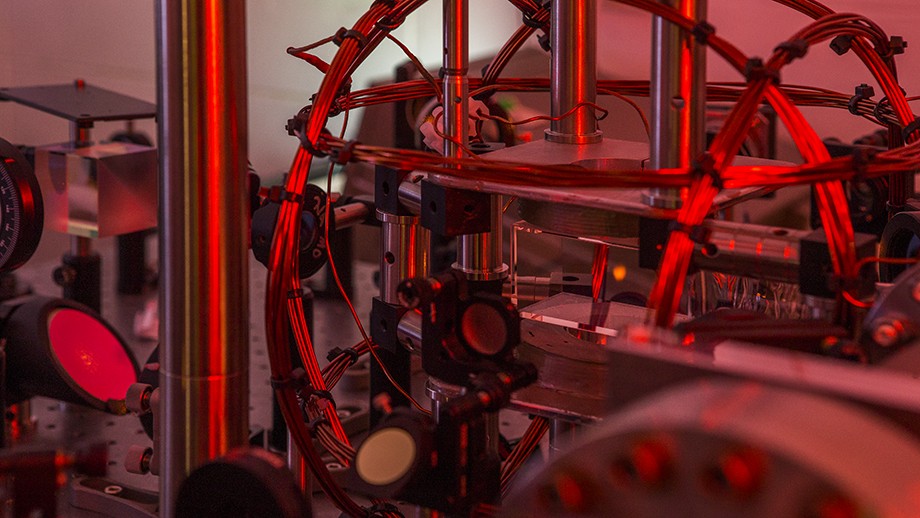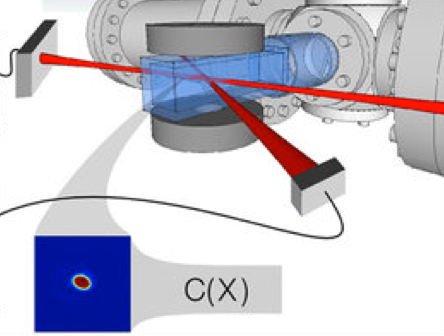Machine learning outperforms physicists in experiment
May 16, 2016

The experiment, featuring the small red glow of a BEC trapped in infrared laser beams (credit: Stuart Hay, ANU)
Australian physicists have used an online optimization process based on machine learning to produce effective Bose-Einstein condensates (BECs) in a fraction of the time it would normally take the researchers.
A BEC is a state of matter of a dilute gas of atoms trapped in a laser beam and cooled to temperatures just above absolute zero. BECs are extremely sensitive to external disturbances, which makes them ideal for research into quantum phenomena or for making very precise measurements such as tiny changes in the Earth’s magnetic field or gravity.
The experiment, developed by physicists from ANU, University of Adelaide and UNSW ADFA, demonstrated that “machine-learning online optimization” can discover optimized condensation methods “with less experiments than a competing optimization method and provide insight into which parameters are important in achieving condensation,” the physicists explain in an open-access paper in the Nature group journal Scientific Reports.
Faster, cheaper than a physicist

Optical dipole trap used in the experiment, showing the three laser beams and the condensate (red-yellow oval in blue square) (credit: P. B. Wigley et al./Scientific Reports)
The team cooled the gas to around 5 microkelvin. To further cool down the trapped gas (containing about 40 million rubidium atoms) to on the order of nanokelvin*, they then handed control of the three laser beams** over to the machine-learning program.
The physicists were surprised by the clever methods the system came up with to create a BEC, like changing one laser’s power up and down, and compensating with another laser.
“I didn’t expect the machine could learn to do the experiment itself, from scratch, in under an hour,” said co-lead researcher Paul Wigley from ANU Research School of Physics and Engineering. “A simple computer program would have taken longer than the age of the universe to run through all the combinations and work this out.”
Wigley suggested that one could make a working device to measure gravity that you could take in the back of a car, and the AI would automatically recalibrate and fix itself.
“It’s cheaper than taking a physicist everywhere with you,” he said.
* Billionth of a degree above absolute zero — where a phase transition occurs, and a macroscopic number of atoms start to occupy the same quantum state, called Bose-Einstein condensation.
** The 1064 nm beam is controlled by varying the current to the laser, while the 1090 nm beam is controlled using the current and a waveplate rotation stage combined with a polarizing beamsplitter to provide additional power attenuation while maintaining mode stability.
Abstract of Fast machine-learning online optimization of ultra-cold-atom experiments
We apply an online optimization process based on machine learning to the production of Bose-Einstein condensates (BEC). BEC is typically created with an exponential evaporation ramp that is optimal for ergodic dynamics with two-body s-wave interactions and no other loss rates, but likely sub-optimal for real experiments. Through repeated machine-controlled scientific experimentation and observations our ‘learner’ discovers an optimal evaporation ramp for BEC production. In contrast to previous work, our learner uses a Gaussian process to develop a statistical model of the relationship between the parameters it controls and the quality of the BEC produced. We demonstrate that the Gaussian process machine learner is able to discover a ramp that produces high quality BECs in 10 times fewer iterations than a previously used online optimization technique. Furthermore, we show the internal model developed can be used to determine which parameters are essential in BEC creation and which are unimportant, providing insight into the optimization process of the system.